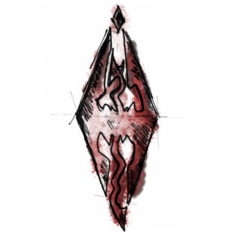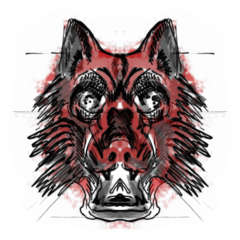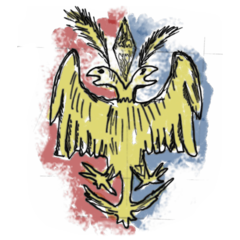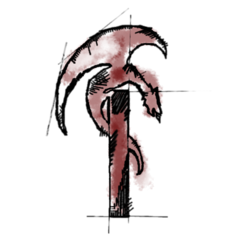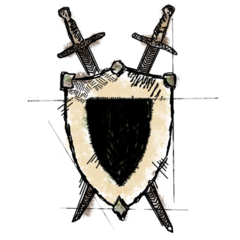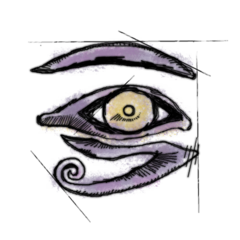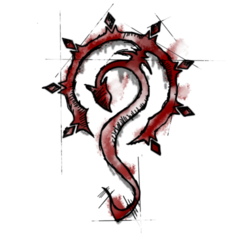Tamriel Data:Imperial Heraldry in Morrowind
|
Book Information Imperial Heraldry in Morrowind |
|||
|---|---|---|---|
| Added by | Tamriel Data | ||
| ID | T_Bk_ImperialHeraldryMwTR | ||
| 75 | 4 | ||
| Locations | |||
Found in the following locations:
|
|||
The most recognized symbol of the Empire, few are aware that the Imperial Dragon is in fact of foreign origin. Emperor Reman Cyrodiil assumed it from the Tsaesci of Akavir after his victory over them at Pale Pass in 1E 2703, when the awestruck snakemen hailed him as dragon's blood. The dragon has been the sigil of the Empire and its dragonblood Emperors ever since. To honor the Eight Divines the beast is stylized in the shape of a diamond with four corners and four sides. The diamond above the dragon was added in the 3rd Era to denote Tiber Septim, or Talos, as the Ninth Divine.
Also known as the 'Wolf of Symmachus', this emblem serves as the official sigil of the King of Morrowind and can be seen in the banners of the royal palace in Mournhold. Originally the personal coat of arms of General Symmachus--a trusted servant of Tiber Septim, it later became the symbol for Morrowind's newly formed royal house after the province's annexation by the Empire. The wolf symbolizes the King's loyalty to the standing Emperor as it once symbolized Symmachus' ardent loyalty to Tiber Septim himself. Notice how the dragon motif is completely absent in this King Helseth version of the sigil whereas it was still present during King Llethan's reign.
The double-headed eagle was first brought to Morrowind by the Nords of Skyrim under King Vrage in the early First Era. Associating the eagle with their matron deity Kyne, the Nords would paint the symbol on their faces and shields hoping to win the goddess' favor. After King Vrage ended his successful campaign in Morrowind, the eagle, traditionally shown swooping up from Atmora, was revised to have two heads looking in opposite directions signifying the Nords' dominance over both east and west, fiery Dunmereth and frigid Skyrim. It was only natural that the Empire would adopt the already well-known sigil for itself after conquering both provinces, placing the Imperial Dragon above the eagle.
The lion as a heraldic motif can be traced all the way back to Second Era High Rock. Some eight hundred years ago, it served as the standard of King Emeric of Wayrest, and later became a symbol for the whole Iliac Bay region. It might be surprising to encounter such a western symbol so far away in the east, but the reason for the lions' popularity in Morrowind lies in the province's recent history. Barenziah, the Queen Mother of Morrowind, was also the Queen of Wayrest during her period of exile. A popular notion is that the two lions represent her royal children: Helseth and Morgiah, who spent a great deal of their lives in Wayrest where they received a western noble's upbringing, hence being depicted as lions.
A fine example of a more recent rendition of the Imperial Dragon is the Vaynth Wyrm, which has been around for only a little over two decades. Named after the controversial Simulacrum-era Duchess Vaynth of Firewatch who commissioned it in 3E 394, the wyrm has been the official sigil of the Imperial stronghold ever since. The coat of arms depicts a firebreathing dragon standing on guard atop the famous Firewatch lighthouse. The aggressiveness of the beast is due to a civil war that took place between Firewatch and its rival Old Ebonheart at the time of its creation. In fact, the original Vaynth Wyrm was reversed horizontally so it breathed fire to west, towards Old Ebonheart.
Originally a mercenary fighting force of the Akaviri Potentate, the Fighters Guild was awarded its coat of arms by the Imperial College of Arms in the signing of the Guild Act in 2E 321. The Guild's sigil is stylized after a heraldic achievement. It consists of a plain black-and-white shield with crossed longswords in the background. In the original Second Era design were curved and single-edged after Akaviri fashion, though nowadays the arms in the background are allowed to vary depending on the region where the particular Guild chapter operates. For example, a chapter in Skyrim might use crossed axes instead of longswords.
The oldest Empire-sanctioned Guild in existence, the Mages Guild's coat of arms is definitely unique and exotic in design. The origin story of the coat of arms remains a mystery--some say Vanus Galerion himself first drew it--but as for the symbol itself, there are two popular interpretations. First, it clearly resembles the star constellation of Ritual, a charge of the Mage constellation. Second, it symbolizes the eye of Magnus--the primordial God of Sorcery-known to those who are uninitiated in the arcane mysteries simply as the Sun. Indeed, both the Sun and the Stars are known by mages and astronomers as 'gateways' through which magicka flows to our mortal plane.
Derived from the sigil of the Tamrielic All-Flags Navy, the Empire's naval insignia depicts the Dragon of Akatosh curled up in the shape of a ship's wheel with eight spokes. The body of Akatosh represents Cyrodiil itself, while the diamond spokes protruding from the dragon's wings represent the projection of Imperial power over the other eight provinces of Tamriel. The wheel can also be seen as a simplified representation of the Nine Divines, Akatosh being the centre figure, surrounded by the other eight Divines.
